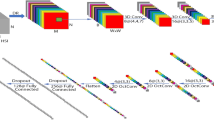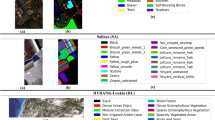Abstract
The application of deep learning techniques in hyperspectral satellite images (HSI) classification has led to a significant increase in accuracy compared to machine learning techniques. The research objective is now shifted toward gaining classification accuracy with less number of spectral bands and training samples. With this research objective, the recent development of the hybrid convolution neural network (CNN) has resulted in the improvement of the accuracy of land use land cover classification of hyperspectral satellite images (HSI) and also provided a new dimension to explore. This paper proposes a variant of the 3D-2D CNN Hybrid model to extract representational features from a different class of land use land cover using different receptive fields in a multi-stack arrangement. The proposed model focused on reducing the number of bands required for classification and training samples but on the other hand improving the diverse representational feature extraction. The paper also explores through experimentation the possible replacement of monotonic activation function ReLu using non-monotonic functions like Swish and Mish in 3D-2D CNN Hybrid models. The experiments are carried out using publically available HSI datasets with a special focus on small training datasets to establish the efficiency and robustness of the proposed model.










Similar content being viewed by others
References
Roy SK, Krishna G, Dubey SR, Chaudhuri BB (2019) Hybridsn: exploring 3-d-2-d cnn feature hierarchy for hyperspectral image classification. IEEE Geosci Remote Sens Lett 17:277–281
Zhang H, Meng L, Wei X, Tang X, Tang X, Wang X, Jin B, Yao W (2019) 1D-convolutional capsule network for hyperspectral image classification. arXiv preprint http://arxiv.org/abs/1903.09834
Zheng Z, Zhang Y, Li L, Zhu M, He Y, Li M, Guo Z, et al. (2017) Classification based on deep convolutional neural networks with hyperspectral image. In: 2017 IEEE international geoscience and remote sensing symposium (IGARSS), pp 1828–1831. IEEE, 2017
Yang J, Zhao Y, Chan JCW, Yi C (2016) Hyperspectral image classification using two-channel deep convolutional neural network. In: 2016 IEEE international geoscience and remote sensing symposium (IGARSS), pp 5079–5082. IEEE, 2016
Aptoula E, Ozdemir MC, Yanikoglu B (2016) Deep learning with attribute profiles for hyperspectral image classification. IEEE Geosci Remote Sens Lett 13(12):1970–1974
Zhao W, Shihong Du (2016) Spectral–spatial feature extraction for hyperspectral image classification: a dimension reduction and deep learning approach. IEEE Trans Geosci Remote Sens 54(8):4544–4554
He N, Paoletti ME, Haut JM, Fang L, Li S, Plaza A, Plaza J (2018) Feature extraction with multiscale covariance maps for hyperspectral image classification. IEEE Trans Geosci Remote Sens 57(2):755–769
Dong H, Zhang L, Zou B (2019) Band attention convolutional networks for hyperspectral image classification. arXiv preprint http://arxiv.org/abs/1906.04379
Li Y, Zhang H, Shen Q (2017) Spectral–spatial classification of hyperspectral imagery with 3D convolutional neural network. Remote Sens 9(1):67
Chen Y, Jiang H, Li C, Jia X, Ghamisi P (2016) Deep feature extraction and classification of hyperspectral images based on convolutional neural networks. IEEE Trans Geosci Remote Sens 54(10):6232–6251
Lu Z, Bin Xu, Sun Le, Zhan T, Tang S (2020) 3-D Channel and spatial attention based multiscale spatial–spectral residual network for hyperspectral image classification. IEEE J Selected Top Appl Earth Observ Remote Sens 13:4311–4324
Feng F, Wang S, Wang C, Zhang J (2019) Learning deep hierarchical spatial-spectral features for hyperspectral image classification based on residual 3D–2D CNN. Sensors 19(23):5276
Gao Q, Lim S, Jia X (2018) Hyperspectral image classification using convolutional neural networks and multiple feature learning. Remote Sens 10(2):299
Qi W, Zhang X, Wang N, Zhang M, Cen Yi (2019) A Spectral-spatial cascaded 3D convolutional neural network with a convolutional long short-term memory network for hyperspectral image classification. Remote Sens 11(20):2363
Simonyan K, Zisserman A (2014) Very deep convolutional networks for large-scale image recognition. arXiv preprint http://arxiv.org/abs/1409.1556
Luo W, Li Y, Urtasun R, Zemel R (2016) Understanding the effective receptive field in deep convolutional neural networks. In: Advances in neural information processing systems, pp 4898–4906
Paoletti ME, Haut JM, Plaza J, Plaza A (2018) A new deep convolutional neural network for fast hyperspectral image classification. ISPRS J Photogramm Remote Sens 145:120–147
Hinton GE, Srivastava N, Krizhevsky A, Sutskever I, Salakhutdinov RR (2012) Improving neural networks by preventing co-adaptation of feature detectors. arXiv preprint http://arxiv.org/abs/1207.0580
Caruana, Rich, Steve Lawrence, and C. Lee Giles. "Overfitting in neural nets: Backpropagation, conjugate gradient, and early stopping." In Advances in neural information processing systems, pp. 402–408. 2001.
Kumar SK (2017) On weight initialization in deep neural networks. arXiv preprint http://arxiv.org/abs/1704.08863
He K, Zhang X, Ren S, Sun J (2015) Delving deep into rectifiers: Surpassing human-level performance on imagenet classification. In: Proceedings of the IEEE international conference on computer vision, pp 1026–1034
Kingma DP, Ba J (2014) Adam: a method for stochastic optimization. arXiv preprint http://arxiv.org/abs/1412.6980
Ramachandran P, Zoph B, Le QV (2017) Searching for activation functions. arXiv preprint http://arxiv.org/abs/1710.05941
Misra D (2019) Mish: a self regularized non-monotonic neural activation function. arXiv preprint http://arxiv.org/abs/1908.08681
Zhong Z, Li J, Luo Z, Chapman M (2017) Spectral–spatial residual network for hyperspectral image classification: a 3-D deep learning framework. IEEE Trans Geosci Remote Sens 56(2):847–858
Author information
Authors and Affiliations
Corresponding author
Ethics declarations
Conflict of interest
No potential conflict of interest is reported by the author(s).
Additional information
Publisher's Note
Springer Nature remains neutral with regard to jurisdictional claims in published maps and institutional affiliations.
Rights and permissions
About this article
Cite this article
Bandyopadhyay, M. Multi-stack hybrid CNN with non-monotonic activation functions for hyperspectral satellite image classification. Neural Comput & Applic 33, 14809–14822 (2021). https://doi.org/10.1007/s00521-021-06120-5
Received:
Accepted:
Published:
Issue Date:
DOI: https://doi.org/10.1007/s00521-021-06120-5




